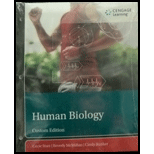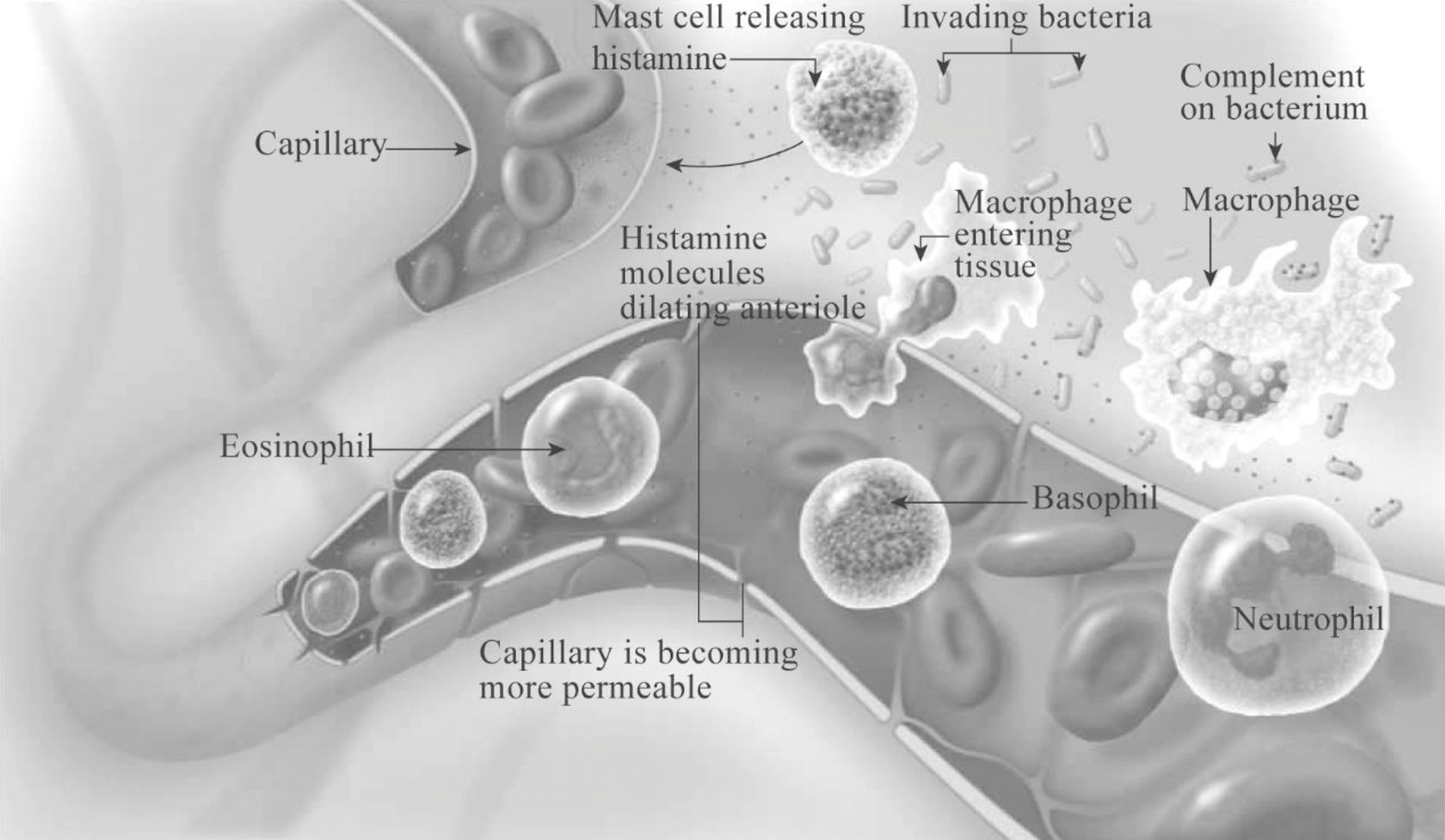
To describe: The signs of inflammation that came in the given statement.
Introduction: An inflammation is the sequence of events in response to the infections that would limit the effects of injury or any agent in the body. It is the biological response against the harmful stimuli to eliminate the initial cause of the healthy tissue injury or damage. Its main function is to act as a defense mechanism of the body to remove the injurious agents from the body to prevent infections.
Explanation of Solution
Given statement: While jogging in the surf, a person’s toes land on a jelly fish. The bottom of the toes becomes swollen, red, and warm to touch.
In the given case, the sting of the jellyfish causes inflammation that accompanies the visible signs such as redness, swelling, warmth, and pain. The inflammation begins through a signal provided by the damage caused by the sting. The basic steps involved in the inflammation are caused by the sting of jelly fish as follows:
Basic steps involved:
- 1. Release of various chemicals: Numerous chemicals such as histamine, interleukins, tumor necrosis factors (TNFs), chemotactic factors, leukotriene, and prostaglandins are released by the damaged cells of injured tissues basophils, mast cells, macrophages, dendritic cells, and infectious organisms to promote inflammation.
- 2. Vascular changes: The released chemical causes many local effects on the blood vessels such as:
- Increased vascular permeability
- Arteriolar vasodilation
- Leukocyte adhesion
- 3. Leukocyte recruitment:The movement of the leukocyte through the blood at the site of infection occurs by the following processes:
- a) Margination: The cell adhesion molecules (CAM) present on the surface of the leukocytes (first neutrophil and then macrophages) adhere to the endothelial capillaries present within the injured tissue.
- b) Diapedesis: Here, the cells migrate to the site of infection by exiting the blood through “squeezing out” between the vessel walls.
- c)
Chemotaxis : Chemotaxis is the movement of cells along a chemical gradient formed due to the chemicals release by the damaged cells, dead cells, or invading pathogens. Cytokines and granulocyte-macrophage colony-stimulating factor (GM-CSF) are released to attract more macrophages to the site of infection. IL-1 released by macrophages induces fever in the body. - d) Delivery of plasma proteins: Several plasma proteins such as immunoglobulin’s complement, clotting proteins, and kinins are brought into the infection site that cause local effects such as increased vascular permeability, pain, heat, and swelling on the infected site.
- 4. Tissue repair and healing:Immune cells and their secretions process the pathogen and the newly formed lymph carries the pathogen with the unwanted dead cells and cell debris from the interstitial space of the tissue. The exudate (fluid and cellular/protein mix) is passed through the lymph nodes for monitoring, transported liver, and then, removed from the body.
- 1. Redness: Inflammation increases the vascular permeability which causes the flow of a large amount of blood toward the site of infection. Due to the increased blood flow, there will be redness at the site of infection.
- 2. Heat: The heat will be generated at the site of infection due to the increased blood flow as well as the increased
metabolic activity of cells within the area. - 3. Swelling: As a result of inflammation, a large amount of fluid is lost from capillaries into the interstitial space that causes swelling around the injured site.
- 4. Pain: Pain occurs when the pain receptors are stimulated due to the compression from the accumulation of interstitial fluid and by the irritation of the released microbial substances, kinins, or prostaglandins.
- 5. Loss of function: Loss of function occurs due to the pain and swelling.
The cardinal signs of inflammation are as follows:
Thus, several immune factors produced as a result of inflammation neutralize the toxin from the jellyfish.
Pictorial representation: Fig.1 shows the steps in the inflammatory response followed by bacterial invasion and activation of immune cells at the site of injury.

Fig.1: Basic steps in inflammatory response
Want to see more full solutions like this?
Chapter 9 Solutions
Human Biology Custom Edition
- Describe and give a specific example of how successionary stage is related to species diversity?arrow_forwardExplain down bellow what happens to the cell in pictures not in words: Decreased pH in mitochondria Increased ATP Decreased pH in cytosol Increased hydrolysis Decreasing glycogen and triglycerides Increased MAP kinase activity Poor ion transport → For each one:→ What normally happens?→ What is wrong now?→ How does it mess up the cell?arrow_forward1.) Community Diversity: The brown and orange line represent two different plant communities. a. Which color represents the community with a higher species richness? b. Which color represents the community with a higher species evenness? Relative abundance 0.1 0.04 0.001 2 4 6 8 10 12 14 16 18 20 22 24 Rank abundance c. What is the maximum value of the Simpson's diversity index (remember, Simpson's index is D = p², Simpson's diversity index is 1-D)? d. If the Simpson's diversity index equals 1, what does that mean about the number of species and their relative abundance within community being assessed?arrow_forward
- 1.) Community Diversity: The brown and orange line represent two different plant communities. a. Which color represents the community with a higher species richness? b. Which color represents the community with a higher species evenness? Relative abundance 0.1 0.04 0.001 2 4 6 8 10 12 14 16 18 20 22 24 Rank abundance c. What is the maximum value of the Simpson's diversity index (remember, Simpson's index is D = p², Simpson's diversity index is 1-D)? d. If the Simpson's diversity index equals 1, what does that mean about the number of species and their relative abundance within community being assessed?arrow_forwardwhat measures can a mother to take to improve the produce of her to milk to her newborn baby ?arrow_forward1. Color the line that represents all ancestors of the Eastern white pine tree green (but only the ancestral line NOT shared with other organisms) 2. Oncle the last common ancestor of the Colorado blue spruce tree and Eastern white pine tree. 3. Put a box around the last common ancestor of the sugar maple tree and the dogwood tree. 4. Put a triangle around the last common ancestor of the red pine tree and the american holly bush. 5. Color the line that represents all ancestors of the Ponderosa pine tree red (including all shared ancestors). 6. Color the line that represents all ancestors of the American elm tree blue (including all shared ancestors). 7 Color the line that represents all ancestors of the Sabal palm tree purple (including all shared ancestors) 8. Using a yellow highlighter or colored pencil, circle the clade that includes all pine trees. 9. Using a orange highlighter or colored pencil, circle the clade that includes all gymnosperms 10. Can you tell…arrow_forward
- You have been hired as a public relations specialist to give invertebrates a good name. After all, they are much more than just creepy crawly bugs! Your first task though is to convince yourself that is true. The best way to do that is to start close to home. Find something in your house that is a product obtained directly from an invertebrate or only due to an invertebrate’s actions. Describe the product, its function and utility, as well as any human manufactured alternatives. Be sure to highlight the advantages of obtaining this directly from nature. Keep in mind, a product can be something you use, wear, eat, or enjoy for its visual appeal.arrow_forwardUse the following tree diagram to answer Questions #8-10. 8) Which of the following two animals are the most closely related based on the tree to the left? a) Pig and camel b) Hippo and pig c) Deer and cow 9) CIRCLE on the tree diagram where the common ancestor between a hippo and a cow is. 10) Put a SQUARE on the tree diagram where the common ancestor between a pig and a peccary is.arrow_forwardExplain: Healthy Cell Function Overview→ Briefly describe how a healthy cell usually works: metabolism (ATP production), pH balance, glycogen storage, ion transport, enzymes, etc. Gene Mutation and Genetics Part→ Focus on the autosomal recessive mutation and explain: How gene mutation affects the cell. How autosomal inheritance works. Compare the normal and mutated gene sequences simply. → Talk about possible consequences of a faulty hydrolytic enzyme.arrow_forward
- Can you fill out those termsarrow_forwardExplain down bellow what happens to the cell: Decreased pH in mitochondria Increased ATP Decreased pH in cytosol Increased hydrolysis Decreasing glycogen and triglycerides Increased MAP kinase activity Poor ion transport → For each one:→ What normally happens?→ What is wrong now?→ How does it mess up the cell?arrow_forwardAn 1100 pound equine patient was given 20 mg/kg sucralfate 3 times a day, 2.8 mg/kg famotidine twice a day, and 10mg/kg doxycycline twice a day. Sucralfate comes as a 1 gm tablet, famotidine as 20 mg tablets, and doxycycline as 100mg tablets. All are in bottles of 100 tablets.How many total mg are needed for the patient and how many tablets of each would be needed to provide each dose?How many bottles of each would be needed to have available if this patient were to be on this drug regimen for 5 days?arrow_forward
 Human Biology (MindTap Course List)BiologyISBN:9781305112100Author:Cecie Starr, Beverly McMillanPublisher:Cengage Learning
Human Biology (MindTap Course List)BiologyISBN:9781305112100Author:Cecie Starr, Beverly McMillanPublisher:Cengage Learning Human Heredity: Principles and Issues (MindTap Co...BiologyISBN:9781305251052Author:Michael CummingsPublisher:Cengage Learning
Human Heredity: Principles and Issues (MindTap Co...BiologyISBN:9781305251052Author:Michael CummingsPublisher:Cengage Learning Biology (MindTap Course List)BiologyISBN:9781337392938Author:Eldra Solomon, Charles Martin, Diana W. Martin, Linda R. BergPublisher:Cengage Learning
Biology (MindTap Course List)BiologyISBN:9781337392938Author:Eldra Solomon, Charles Martin, Diana W. Martin, Linda R. BergPublisher:Cengage Learning Human Physiology: From Cells to Systems (MindTap ...BiologyISBN:9781285866932Author:Lauralee SherwoodPublisher:Cengage Learning
Human Physiology: From Cells to Systems (MindTap ...BiologyISBN:9781285866932Author:Lauralee SherwoodPublisher:Cengage Learning Anatomy & PhysiologyBiologyISBN:9781938168130Author:Kelly A. Young, James A. Wise, Peter DeSaix, Dean H. Kruse, Brandon Poe, Eddie Johnson, Jody E. Johnson, Oksana Korol, J. Gordon Betts, Mark WomblePublisher:OpenStax College
Anatomy & PhysiologyBiologyISBN:9781938168130Author:Kelly A. Young, James A. Wise, Peter DeSaix, Dean H. Kruse, Brandon Poe, Eddie Johnson, Jody E. Johnson, Oksana Korol, J. Gordon Betts, Mark WomblePublisher:OpenStax College Concepts of BiologyBiologyISBN:9781938168116Author:Samantha Fowler, Rebecca Roush, James WisePublisher:OpenStax College
Concepts of BiologyBiologyISBN:9781938168116Author:Samantha Fowler, Rebecca Roush, James WisePublisher:OpenStax College





